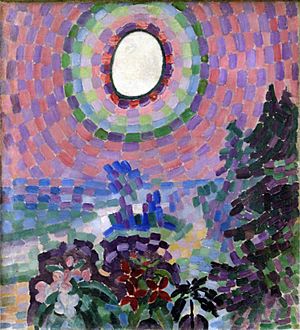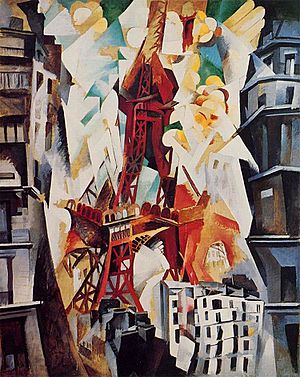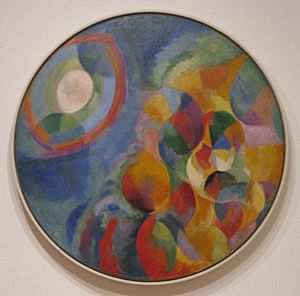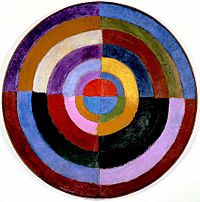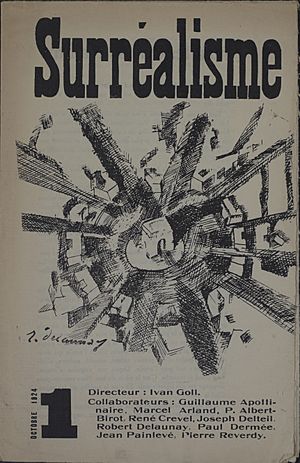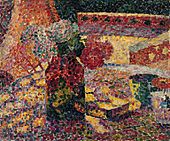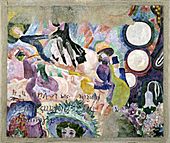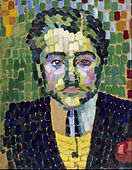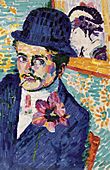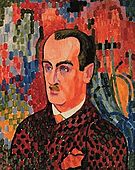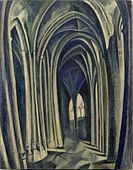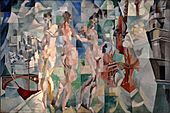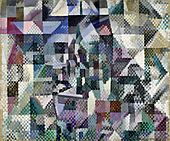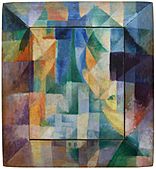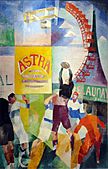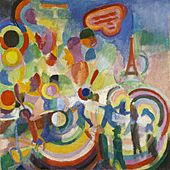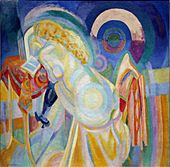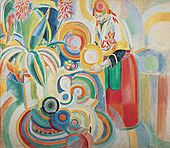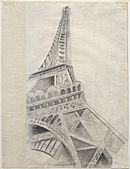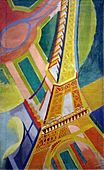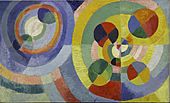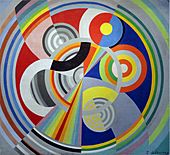Robert Delaunay facts for kids
Quick facts for kids
Robert Delaunay
|
|
|---|---|
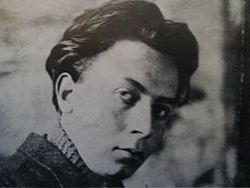
Robert Delaunay
|
|
| Born |
Robert-Victor-Felix Delaunay
12 April 1885 Paris, France
|
| Died | 25 October 1941 (aged 56) Montpellier, France
|
| Known for | Painting |
| Movement | Divisionism, Cubism, Orphism, Abstract art |
Robert Delaunay (born April 12, 1885 – died October 25, 1941) was a famous French artist. He is known for starting an art style called Orphism with his wife, Sonia Delaunay. This style uses bright colors and geometric shapes. Later in his career, his art became even more abstract, meaning it didn't show real-world objects. Robert Delaunay was important because he used bold colors and loved to try new things with how light and color appeared in his paintings.
Contents
Understanding Orphism and Delaunay's Art
Robert Delaunay is best known for his work in Orphism. From 1912 to 1914, he created paintings that didn't show specific objects. Instead, he used bright, moving colors that became the main focus of the artwork. He believed that color and light were the most important parts of a painting. His ideas influenced many other artists, like Paul Klee and Franz Marc. An art critic named Guillaume Apollinaire was also very interested in Delaunay's ideas about color. He used them to explain what Orphism was all about. Delaunay studied color deeply, believing it could express feelings and create shapes all on its own.
Famous Painting Series
During his most active years, Delaunay painted several series of artworks. Each series explored different ideas and themes:
- The Saint-Sévrin series (1909–10)
- The City series (1909–1911)
- The Eiffel Tower series (1909–1912)
- The City of Paris series (1911–12)
- The Window series (1912–1914)
- The Cardiff Team series (1913)
- The Circular Forms series (1913)
- The First Disk (1913)
Delaunay's Ideas About Color
Delaunay wrote about his thoughts on color, which were inspired by scientists. He felt that color had its own power to express things and create forms. He believed painting was a purely visual art. It depended on how colored light affected the eye. He thought that different colors, when placed next to each other, would create movement in the eye. This movement, he felt, was like the movement found in nature. For Delaunay, seeing itself became the main subject of his art.
How His Style Changed
Delaunay's early paintings were influenced by Neoimpressionism. For example, his painting Night Scene uses bright colors and lively brushstrokes. These strokes don't define clear objects but instead show the areas around them.
Later, he stopped using the specific colors of Neoimpressionism. His Eiffel Tower series showed objects breaking apart and blending with the space around them. This series was influenced by artists like Cézanne and art styles like Cubism and Futurism. In his Eiffel Tower paintings, objects and space mix together. The geometric shapes move with more energy than the still shapes found in Cubist art.
Robert Delaunay's Life Story
Early Life and Art Training
Robert Delaunay was born in Paris, France, on April 12, 1885. His parents divorced when he was young. He was raised by his aunt and uncle, Marie and Charles Damour. When he was 17, he decided he wanted to be a painter. In 1902, his uncle sent him to a workshop in Paris to study Decorative Arts.
Starting His Art Career
At 19, Delaunay left the workshop to focus on painting full-time. In 1904, he showed six of his paintings at an art show called the Salon des Indépendants. He traveled to Brittany, a region in France, where he was influenced by a group of artists called the Pont-Aven School. In 1906, he showed more of his works from Brittany and met another artist, Henri Rousseau.
Delaunay became good friends with Jean Metzinger. They even had an exhibition together in 1907. An art critic noticed their work and called them Divisionists. He said they used large, mosaic-like "cubes" in their paintings.
A writer named Robert Herbert noted that Metzinger and Delaunay often painted together around 1906 and 1907. They even painted portraits of each other. Herbert described how the sun in Metzinger's painting, Coucher de soleil no. 1, and Delaunay's Paysage au disque seemed to vibrate. This showed their interest in how light breaks into different colors, which was a key idea in Neo-Impressionism.
Metzinger and Delaunay developed a new style of Neo-Impressionism. This style later became very important for their Cubist artworks. Other artists, like Piet Mondrian and the Futurists, also used similar techniques.
In 1908, Delaunay met Sonia Terk. She was an artist who would soon become his wife. In 1909, Delaunay started painting a series of artworks about Paris and the Eiffel Tower, known as the Eiffel Tower series.
The next year, he married Sonia Terk. They had a son named Charles in 1911. That same year, Delaunay joined a group of artists in Germany called The Blue Rider (Der Blaue Reiter). He was very successful in Germany, Switzerland, and Russia. He sold four paintings at the first Blue Rider exhibition. His work was very popular with the group. Delaunay's connection with The Blue Rider led to an article about his painting methods in their 1912 book. He also showed his art in other exhibitions in Munich and Moscow.
Delaunay described his art around 1912, saying: "Cubism was very popular. My paintings looked like prisms compared to what other Cubist artists were doing. I was different from the Cubists. I had big arguments with my friends who didn't use color in their paintings. They said I was going back to an older style or just making decorative art. But I felt I was close to reaching my goal."
The year 1912 was a big moment for Delaunay. His first major exhibition in Paris closed in March. It showed 46 of his works, from his early Divisionist period to his Cubist Eiffel Tower paintings. Guillaume Apollinaire praised his work, calling Delaunay "an artist who sees the world in a grand way."
In a magazine from March 1912, it was suggested that Delaunay had moved away from the Cubist group. A review said that Delaunay wanted to work alone and felt he had nothing in common with other Cubists.
In January 1913, Delaunay traveled to Berlin with Apollinaire for an exhibition of his art. On their way back to Paris, they visited artist August Macke. When his painting La ville de Paris was rejected from an art show in New York because it was too big, he had all his other works removed from the show.
Years in Spain and Portugal (1914–1920)
When World War I started in 1914, Sonia and Robert were in Spain. They decided not to go back to France and stayed in Madrid. In 1915, they moved to Portugal. There, they discussed art with other friends and artists. Robert was first called a deserter from the French military, but later he was found unfit for military service in 1916.
The Russian Revolution meant Sonia's family in Russia could no longer send them money. They needed a new way to earn a living. In 1917, the Delaunays met Sergei Diaghilev, who produced ballets. Robert designed the stage for Diaghilev's show Cleopatra. Robert also created illustrations for a book called Tour Eiffel.
In 1920, a fashion designer refused to work with Sonia, partly because Robert had been called a deserter. The Der Sturm gallery in Berlin showed paintings by Sonia and Robert from their time in Portugal that same year.
Returning to Paris and Later Life (1921–1941)
After the war, in 1921, the Delaunays returned to Paris. Robert continued to create both realistic and abstract art. For a short time, he also explored Surrealism. He met artists like André Breton and Tristan Tzara, who introduced him to the Dada and Surrealist art groups. At the 1937 World Fair in Paris, Delaunay helped design the railway and air travel buildings.
When World War II began, the Delaunays moved to the Auvergne region to avoid the invading German forces. Robert was suffering from cancer and found it hard to move around. His health got worse, and he died of cancer on October 25, 1941, in Montpellier. He was 56 years old. His body was later reburied in 1952.
Gallery
Museum Collections
You can find Robert Delaunay's artworks in many museums and private collections around the world:
Europe
- The Musée National d'Art Moderne in Paris, France
- The Musée d'Art Moderne de Paris, France
- The Neue Nationalgalerie in Berlin, Germany
- The Bilbao Fine Arts Museum in Spain
- Kunstmuseum Basel in Switzerland
- The National Galleries of Scotland
- The New Art Gallery in Walsall, England
- Palazzo Cavour in Turin, Italy
- The Peggy Guggenheim Collection in Venice, Italy
- National Museum of Serbia
- Van Abbemuseum in Eindhoven, The Netherlands
- Palais des Beaux-Arts de Lille in France
United States
- The Albright-Knox Art Gallery in Buffalo, New York
- The Art Institute of Chicago
- The Columbus Museum of Art
- The Berkeley Art Museum
- The Minneapolis Institute of Arts
- The Fine Arts Museums of San Francisco
- The Frances Lehman Loeb Art Center at Vassar College in Poughkeepsie, New York
- The Guggenheim Museum in New York City
- The Honolulu Museum of Art
- The Museum of Modern Art in New York City
- The National Gallery of Art in Washington, D.C.
- The Dallas Museum of Art in Dallas, Texas
- The San Diego Museum of Art
- The Philadelphia Museum of Art
- The Saint Louis Art Museum in Saint Louis, Missouri
Rest of the World
- The National Gallery of Victoria in Australia
- The Aichi Prefectural Museum of Art in Japan
Publications About Delaunay
- Baron, Stanley; Damase, Jacques (1995). Sonia Delaunay: The Life of an Artist. Harry N. Abrahams. ISBN 0-8109-3222-9. https://archive.org/details/soniadelaunay00baro.
- Düchting, Hajo (1995). Delaunay. Taschen. ISBN 3-8228-9191-6.
- Robert Delaunay – Sonia Delaunay: Das Centre Pompidou zu Gast in Hamburg. Hamburger Kunsthalle. 1999. ISBN 9783770152162.
- Gordon Hughes (1997). Envisioning Abstraction: The Simultaneity Of Robert Delaunay's First Disk.
See also
 In Spanish: Robert Delaunay para niños
In Spanish: Robert Delaunay para niños
- Abstraction Creation


